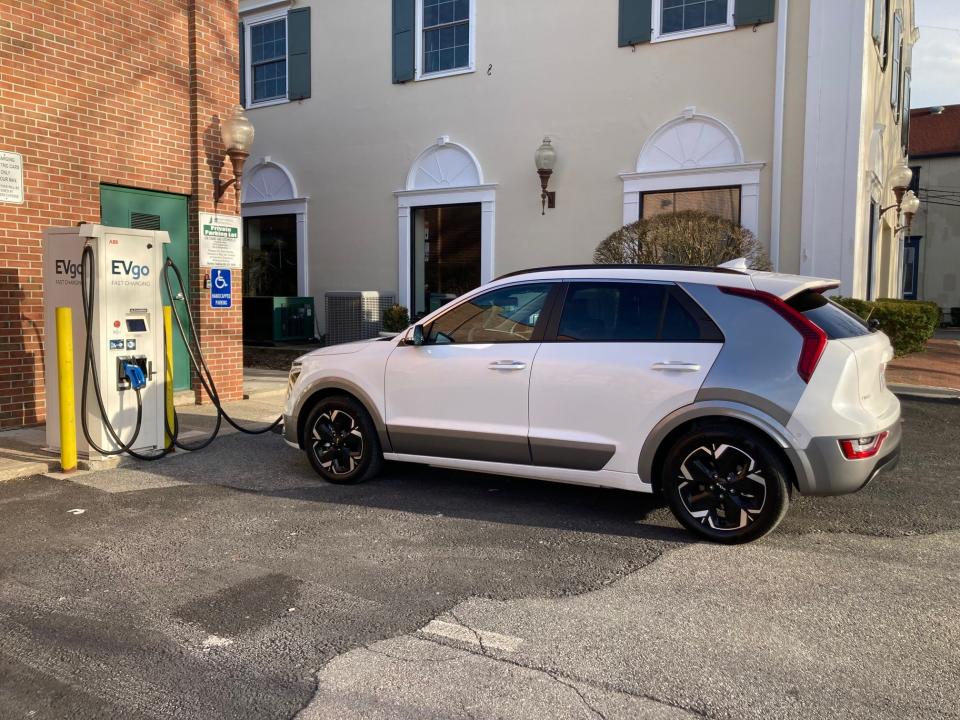Biden slows his timeline for the shift to EVs in a compromise with unions concerned about jobs

The EPA issued its strictest-ever tailpipe pollution limits for vehicles sold between 2027 and 2032.
The rule is more lenient than originally proposed after the auto industry and unions expressed concerns over the tight timeline.
Despite the delay, the new limits are expected to avoid the same amount of pollution long-term.
President Joe Biden is giving automakers more time to ramp up sales of electric vehicles, following pressure from the industry and labor unions concerned about a rapid transition to EVs.
The Environmental Protection Agency on Wednesday issued the strictest limits to date on tailpipe pollution from cars, SUVs, pickup trucks, and vans sold between 2027 and 2032. In effect, the rules could boost EVs to up to 56% of new car sales — a big jump from 7.6% in 2023 — while hybrids could account for about 13% of sales, according to senior administration officials.
The final rule is more relaxed than a draft issued last year that would have spurred faster growth in EV sales this decade and estimated they'd account for 67% of new car sales by 2032. The rules also outline how automakers can sell a mix of EVs, hybrids, and cleaner gas cars to fall within the pollution caps. The changes were based on feedback from automakers and labor unions that asked for more lead time and flexibility, senior administration officials told reporters.
The compromise reflects Biden's attempt to combat the climate crisis with buy-in from industry and unions, especially during an election year. Cars are the single-largest source of greenhouse gas emissions. Still, the United Auto Workers worries that a rapid shift to EVs will cost jobs because EV manufacturing requires fewer assembly parts. Biden's support from UAW has been a key part of his political coalition. Meanwhile, legacy automakers are scaling back or delaying EV investments as the market grows slower than investor expectations.
"These adjusted EV targets — still a stretch goal — should give the market and supply chains a chance to catch up," John Bozzella, president and CEO of the Alliance for Automotive Innovation, said in a statement. The group represents companies that make about 97% of the new vehicles sold in the US. "It buys some time for more public charging to come online, and the industrial incentives and policies of the Inflation Reduction Act to do their thing."
Pacing EV adoption
The tailpipe rules land as the EV market hits some bumps in the road.
US automakers sold a record 1.2 million EVs last year, but there was a slowdown in the fourth quarter, according to Kelley Blue Book. That means the market still grew, just not as fast as previous quarters. The trend prompted companies like Ford and General Motors to scale back production, citing lower-than-expected demand from drivers worried about finding charging stations.
That concern has led hybrids, which have both gas and battery power, to gain popularity.
Still, analysts predict that EV sales will continue to push higher, thanks to newer models at more affordable prices and the continued build-out of charging stations. The average new car sells for around $46,000, while the average new EV costs closer to $50,000, J.D. Power said. EV drivers also save money on gas and maintenance.
"The United States has a history of meeting and exceeding these targets because of the broad appeal of fuel-efficient vehicles and electric vehicles being underestimated," Albert Gore, executive director of the Zero Emissions Transportation Association, which advocates for EV makers like Tesla and Rivian, told Business Insider. "We still believe the transition will take place on a shorter timeline."
Less pollution, fewer deaths
Even though the EPA is delaying a sharp uptick in EV sales, the final rule is still expected to avoid the same amount of pollution over the long term, the agency said.
Some 7.2 billion tons of carbon dioxide emissions — or about four times the emissions of the entire transportation sector — would be avoided through 2055.
Air pollutants like fine particulate matter and nitrogen oxide that cause smog would be drastically reduced by that date, preventing up to 2,500 premature deaths and reducing heart attacks, respiratory illnesses, and aggravated asthma, according to EPA.
Research indicates that less air pollution leads to longer lives. Cleaner air was responsible for more than a third of the decline in mortality during the Great Recession as fewer people drove to work and factories closed.
But some climate groups criticized the delayed EV timeline because that means the transportation sector will emit more pollution in the short term, causing the planet to warm faster.
Scientists have warned that countries must slash emissions in half by 2030 to keep the world from warming 1.5 degrees Celsius above preindustrial levels. Beyond that threshold, extreme heat, wildfires, flooding, and other disasters will likely become increasingly catastrophic for humanity.
Senior administration officials said the tailpipe emissions rule, combined with other climate policies like the IRA, will help the US cut emissions in half by 2030.
Read the original article on Business Insider

 Yahoo Autos
Yahoo Autos 